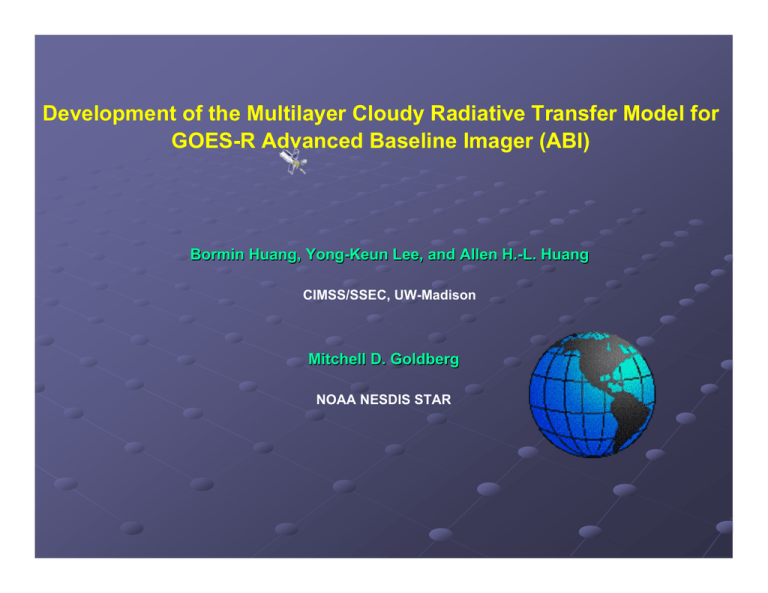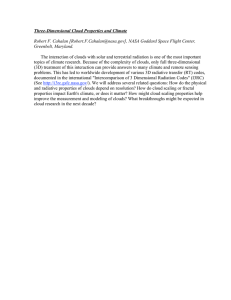Development of the Multilayer Cloudy Radiative Transfer Model for
advertisement

Development of the Multilayer Cloudy Radiative Transfer Model for GOES-R Advanced Baseline Imager (ABI) Bormin Huang, Yong-Keun Lee, and Allen H.-L. Huang CIMSS/SSEC, UW-Madison Mitchell D. Goldberg NOAA NESDIS STAR Outline Multilalyer Clouds – Observation, Modeling & Retrieval Issues Generalized Radiative Transfer Equation for Multilayer Clouds Applications to GOES-R Advanced Baseline Imager (ABI) Summary and Future Work Observations of Multilalyer Clouds Multilalyer clouds frequently occur in frontal areas where cirrus clouds overlie boundary layer convective clouds or stratus clouds (Hahn et al. 1982, 1984). The probability of cirrus clouds overlying low stratus or altostratus clouds was higher than 50% (Tian 1989). Field experiments such as FIRE-I (1986), FIRE-II-Cirrus (1991), UAV-ARESE (1995) and SUCCESS (1996) have also observed multiple cloud layers involving cirrus overlying lower-layer clouds. For a given location, it is common for two or more cloud types to occur simultaneously but at different altitudes in the atmosphere (Baum et al. 1995) . A generalized radiative transfer model to include multilayer clouds is needed for remote sensing! Broken Cloud & Partial Cloud Cover Broken clouds exist in the real world. Partial cover of broken or continuous cloud within a sensor’s field of view (FOV) may exist. Indistinguishable Observations The radiance observations from the following two FOVs may be indistinguishable to the sensor if both FOVs have the same amount of cloud fractions (N1 = N1a + N1b), given the same atmosphere and cloud properties. Limitation of the Plane-Parallel Radiative Transfer Equation The plane-parallel radiative transfer models (e.g. DISORT, SBDART) can simulate the following overcast cloudy atmospheres: but NOT the following atmospheres with partial cloud covers and/or broken clouds: Again, a generalized radiative transfer equation (RTE) for multilayer clouds is desired ! Generalized RTE for the M-Layer Cloud System ¾ We are developing a multilayer cloudy forward model which is not too complicated that it makes the cloudy inverse problem unmanageable, while generalized enough to include multilayer clouds. ¾ For a nonscattering atmosphere with M-layer clouds at most, a sensor’s FOV has up to 2M sub-FOVs. We showed that the observed radiance can be described by: with where Ri is the radiance from the i-th layer cloud (as if it were opaque) and the atmosphere above it, Nk is the FOV fraction corresponding to the k-th sub-FOV. If an i-th layer cloud exists within a sub-FOV, then ki =1, otherwise ki = 0. Example 1: The Generalized RTE for 1-Layer Cloud System. When applied to two adjacent FOVs, it yields the N* method for cloud clearing. When applied to two close CO2 channels, it yields the CO2-slicing method for cloud top pressure retrieval. Example 2: The Generalized RTE for 2-Layer Cloud System. Both the N* and CO2-slicing methods are not applicable to a system with multilayer clouds! 2 ways to form a one-layer cloud system: 10 ways to form a two-layer cloud system: GOES-R ABI Multilayer Cloudy Forward Model One-layer cloud system studies ABI Multilayer Cloudy Forward Model Two-layer cloud system studies Multiple Solutions Exist for the Multilayer Cloudy Retrieval! Summary ¾ The generalized radiative transfer equation for multilayer clouds is developed. ¾The clear-sky atmosphere is its special case when cloud fractions are zero. ¾ Both the N* and CO2-slicing methods are not applicable to multilayer cloud cases. ¾ The GOES-R ABI multilayer cloudy forward model is implemented. ¾ The ABI case studies show some correlations among cloud parameters. Future Work ¾ Implementation of the multilayer cloudy forward model for hyperspectral sounders (e.g. IASI, CrIS, AIRS) ¾ Multilayer cloudy retrieval for the multispectral sensors (e.g. ABI). Not enough bands? Can be done in a “MOPPIT” way, i.e. atmospheric temperature and moisture profiles are supplied from the weather forecast model. Only retrieve cloud parameters with some inter-correlations in mind for parameterized simplification. ¾ Multilayer cloudy retrieval for the hyperspectral sensors. Much easier with thousands of channels for simultaneous retrieval of atmospheric variables and cloudy parameters!





